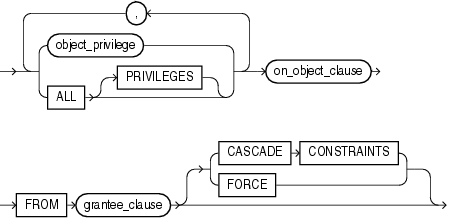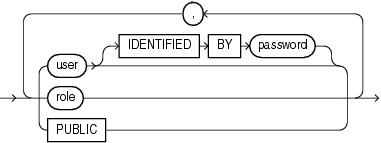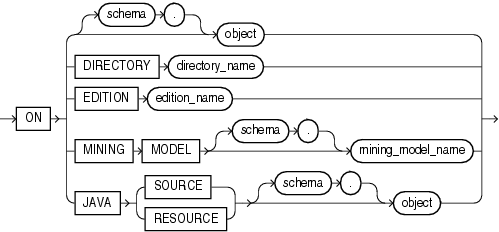| Oracle® Database SQL Language Reference 11g Release 2 (11.2) E41084-02 |
|
|
PDF · Mobi · ePub |
| Oracle® Database SQL Language Reference 11g Release 2 (11.2) E41084-02 |
|
|
PDF · Mobi · ePub |
Revoke system privileges from users and roles
Revoke roles from users and roles
Revoke object privileges for a particular object from users and roles
Note on Oracle Automatic Storage Management A user authenticated AS SYSASM can use this statement to revoke the system privileges SYSASM, SYSOPER, and SYSDBA from a user in the Oracle ASM password file of the current node.
A REVOKE operation to revoke object privileges on an editionable object actualizes the object in the current edition. See Oracle Database Advanced Application Developer's Guide for more information about editions and editionable objects.
See Also:
GRANT for information on granting system privileges and roles
Table 18-2 for a listing of the object privileges for each type of object
To revoke a system privilege, you must have been granted the privilege with the ADMIN OPTION. You can revoke any privilege if you have the GRANT ANY PRIVILEGE system privilege.
To revoke a role, you must have been granted the role with the ADMIN OPTION. You can revoke any role if you have the GRANT ANY ROLE system privilege.
To revoke an object privilege, one of the following conditions must be met:
You must previously have granted the object privilege to the user or role.
You must have the GRANT ANY OBJECT PRIVILEGE system privilege. In this case, you can revoke any object privilege that was granted by the object owner or on behalf of the owner by a user with the GRANT ANY OBJECT PRIVILEGE. However, you cannot revoke an object privilege that was granted by way of a WITH GRANT OPTION grant.
The REVOKE statement can revoke only privileges and roles that were previously granted directly with a GRANT statement. You cannot use this statement to revoke:
Privileges or roles not granted to the revokee
Roles or object privileges granted through the operating system
Privileges or roles granted to the revokee through roles

(revoke_system_privileges::=, revoke_object_privileges::=)


(on_object_clause::=, grantee_clause::=)


Use these clauses to revoke system privileges.
Specify the system privilege to be revoked. Refer to Table 18-1 for a list of the system privileges.
If you revoke a system privilege from a user, then the database removes the privilege from the user's privilege domain. Effective immediately, the user cannot exercise the privilege.
If you revoke a system privilege from a role, then the database removes the privilege from the privilege domain of the role. Effective immediately, users with the role enabled cannot exercise the privilege. Also, other users who have been granted the role and subsequently enable the role cannot exercise the privilege.
See Also:
"Revoking a System Privilege from a User: Example" and "Revoking a System Privilege from a Role: Example"If you revoke a system privilege from PUBLIC, then the database removes the privilege from the privilege domain of each user who has been granted the privilege through PUBLIC. Effective immediately, such users can no longer exercise the privilege. However, the privilege is not revoked from users who have been granted the privilege directly or through roles.
Oracle Database provides a shortcut for specifying all system privileges at once: Specify ALL PRIVILEGES to revoke all the system privileges listed in Table 18-1.
Restriction on Revoking System Privileges A system privilege cannot appear more than once in the list of privileges to be revoked.
Specify the role to be revoked.
If you revoke a role from a user, then the database makes the role unavailable to the user. If the role is currently enabled for the user, then the user can continue to exercise the privileges in the role's privilege domain as long as it remains enabled. However, the user cannot subsequently enable the role.
If you revoke a role from another role, then the database removes the privilege domain of the revoked role from the privilege domain of the revokee role. Users who have been granted and have enabled the revokee role can continue to exercise the privileges in the privilege domain of the revoked role as long as the revokee role remains enabled. However, other users who have been granted the revokee role and subsequently enable it cannot exercise the privileges in the privilege domain of the revoked role.
If you revoke a role from PUBLIC, then the database makes the role unavailable to all users who have been granted the role through PUBLIC. Any user who has enabled the role can continue to exercise the privileges in its privilege domain as long as it remains enabled. However, users cannot subsequently enable the role. The role is not revoked from users who have been granted the role directly or through other roles.
Restriction on Revoking System Roles A system role cannot appear more than once in the list of roles to be revoked. For information on the predefined roles, refer to Oracle Database Security Guide.
FROM grantee_clause identifies users or roles from which the system privilege, role, or object privilege is to be revoked.
PUBLIC Specify PUBLIC to revoke the privileges or roles from all users.
Use these clauses to revoke object privileges.
Specify the object privilege to be revoked. You can substitute any of the object privileges described on Table 18-2.
Note:
Each privilege authorizes some operation. By revoking a privilege, you prevent the revokee from performing that operation. However, multiple users may grant the same privilege to the same user, role, orPUBLIC. To remove the privilege from the grantee's privilege domain, all grantors must revoke the privilege. If even one grantor does not revoke the privilege, then the grantee can still exercise the privilege by virtue of that grant.If you revoke an object privilege from a user, then the database removes the privilege from the user's privilege domain. Effective immediately, the user cannot exercise the privilege.
If that user has granted that privilege to other users or roles, then the database also revokes the privilege from those other users or roles.
If that user's schema contains a procedure, function, or package that contains SQL statements that exercise the privilege, then the procedure, function, or package can no longer be executed.
If that user's schema contains a view on that object, then the database invalidates the view.
If you revoke the REFERENCES object privilege from a user who has exercised the privilege to define referential integrity constraints, then you must specify the CASCADE CONSTRAINTS clause.
If you revoke an object privilege from a role, then the database removes the privilege from the privilege domain of the role. Effective immediately, users with the role enabled cannot exercise the privilege. Other users who have been granted the role cannot exercise the privilege after enabling the role.
If you revoke an object privilege from PUBLIC, then the database removes the privilege from the privilege domain of each user who has been granted the privilege through PUBLIC. Effective immediately, all such users are restricted from exercising the privilege. However, the privilege is not revoked from users who have been granted the privilege directly or through roles.
Specify ALL to revoke all object privileges that you have granted to the revokee. (The keyword PRIVILEGES is provided for semantic clarity and is optional.)
If no privileges have been granted on the object, then the database takes no action and does not return an error.
Restriction on Revoking Object Privileges A privilege cannot appear more than once in the list of privileges to be revoked. A user, a role, or PUBLIC cannot appear more than once in the FROM clause.
See Also:
"Revoking an Object Privilege from a User: Example", "Revoking Object Privileges from PUBLIC: Example", and "Revoking All Object Privileges from a User: Example"This clause is relevant only if you revoke the REFERENCES privilege or ALL [PRIVILEGES]. It drops any referential integrity constraints that the revokee has defined using the REFERENCES privilege, which might have been granted either explicitly or implicitly through a grant of ALL [PRIVILEGES].
Specify FORCE to revoke the EXECUTE object privilege on user-defined type objects with table or type dependencies. You must use FORCE to revoke the EXECUTE object privilege on user-defined type objects with table dependencies.
If you specify FORCE, then all privileges are revoked, all dependent objects are marked INVALID, data in dependent tables becomes inaccessible, and all dependent function-based indexes are marked UNUSABLE. Regranting the necessary type privilege will revalidate the table.
See Also:
Oracle Database Concepts for detailed information about type dependencies and user-defined object privilegesThe on_object_clause identifies the objects on which privileges are to be revoked.
object Specify the object on which the object privileges are to be revoked. This object can be:
A table, view, sequence, procedure, stored function, package, or materialized view
A synonym for a table, view, sequence, procedure, stored function, package, materialized view, or user-defined type
A library, indextype, or user-defined operator
If you do not qualify object with schema, then the database assumes the object is in your own schema.
If you revoke the SELECT object privilege on the containing table or materialized view of a materialized view, whether the privilege was granted with or without the GRANT OPTION, then the database invalidates the materialized view.
If you revoke the SELECT object privilege on any of the master tables of a materialized view, whether the privilege was granted with or without the GRANT OPTION, then the database invalidates both the materialized view and its containing table or materialized view.
DIRECTORY directory_name Specify the directory object on which privileges are to be revoked. You cannot qualify directory_name with schema. The object must be a directory.
EDITION Specify the name of the edition on which the USE object privilege is to be revoked. You cannot qualify edition_name with schema.
JAVA SOURCE | RESOURCE The JAVA clause lets you specify a Java source or resource schema object on which privileges are to be revoked.
Revoking a System Privilege from a User: Example The following statement revokes the DROP ANY TABLE system privilege from the users hr and oe:
REVOKE DROP ANY TABLE
FROM hr, oe;
The users hr and oe can no longer drop tables in schemas other than their own.
Revoking a Role from a User: Example The following statement revokes the role dw_manager from the user sh:
REVOKE dw_manager
FROM sh;
The user sh can no longer enable the dw_manager role.
Revoking a System Privilege from a Role: Example The following statement revokes the CREATE TABLESPACE system privilege from the dw_manager role:
REVOKE CREATE TABLESPACE FROM dw_manager;
Enabling the dw_manager role no longer allows users to create tablespaces.
Revoking a Role from a Role: Example To revoke the role dw_user from the role dw_manager, issue the following statement:
REVOKE dw_user FROM dw_manager;
The dw_user role privileges are no longer granted to dw_manager.
Revoking an Object Privilege from a User: Example You can grant DELETE, INSERT, SELECT, and UPDATE privileges on the table orders to the user hr with the following statement:
GRANT ALL ON orders TO hr;
To revoke the DELETE privilege on orders from hr, issue the following statement:
REVOKE DELETE ON orders FROM hr;
Revoking All Object Privileges from a User: Example To revoke the remaining privileges on orders that you granted to hr, issue the following statement:
REVOKE ALL ON orders FROM hr;
Revoking Object Privileges from PUBLIC: Example You can grant SELECT and UPDATE privileges on the view emp_details_view to all users by granting the privileges to the role PUBLIC:
GRANT SELECT, UPDATE
ON emp_details_view TO public;
The following statement revokes UPDATE privilege on emp_details_view from all users:
REVOKE UPDATE
ON emp_details_view FROM public;
Users can no longer update the emp_details_view view, although users can still query it. However, if you have also granted the UPDATE privilege on emp_details_view to any users, either directly or through roles, then these users retain the privilege.
Revoking an Object Privilege on a Sequence from a User: Example You can grant the user oe the SELECT privilege on the departments_seq sequence in the schema hr with the following statement:
GRANT SELECT
ON hr.departments_seq TO oe;
To revoke the SELECT privilege on departments_seq from oe, issue the following statement:
REVOKE SELECT
ON hr.departments_seq FROM oe;
However, if the user hr has also granted SELECT privilege on departments to sh, then sh can still use departments by virtue of hr's grant.
Revoking an Object Privilege with CASCADE CONSTRAINTS: Example You can grant to oe the privileges REFERENCES and UPDATE on the employees table in the schema hr with the following statement:
GRANT REFERENCES, UPDATE
ON hr.employees TO oe;
The user oe can exercise the REFERENCES privilege to define a constraint in his or her own dependent table that refers to the employees table in the schema hr:
CREATE TABLE dependent
(dependno NUMBER,
dependname VARCHAR2(10),
employee NUMBER
CONSTRAINT in_emp REFERENCES hr.employees(employee_id) );
You can revoke the REFERENCES privilege on hr.employees from oe by issuing the following statement that contains the CASCADE CONSTRAINTS clause:
REVOKE REFERENCES
ON hr.employees
FROM oe
CASCADE CONSTRAINTS;
Revoking oe's REFERENCES privilege on hr.employees causes Oracle Database to drop the in_emp constraint, because oe required the privilege to define the constraint.
However, if oe has also been granted the REFERENCES privilege on hr.employees by a user other than you, then the database does not drop the constraint. oe still has the privilege necessary for the constraint by virtue of the other user's grant.
Revoking an Object Privilege on a Directory from a User: Example You can revoke the READ object privilege on directory bfile_dir from hr by issuing the following statement:
REVOKE READ ON DIRECTORY bfile_dir FROM hr;
Revoke Operations that Use GRANT ANY OBJECT PRIVILEGE: Example Suppose that the database administrator has granted GRANT ANY OBJECT PRIVILEGE to user sh. Now suppose that user hr grants the update privilege on the employees table to oe:
CONNECT hr GRANT UPDATE ON employees TO oe WITH GRANT OPTION;
This grant gives user oe the right to pass the object privilege along to another user:
CONNECT oe GRANT UPDATE ON hr.employees TO pm;
User sh, who has the GRANT ANY OBJECT PRIVILEGE, can now act on behalf of user hr and revoke the update privilege from user oe, because oe was granted the privilege by hr:
CONNECT sh REVOKE UPDATE ON hr.employees FROM oe;
User sh cannot revoke the update privilege from user pm explicitly, because pm received the grant neither from the object owner (hr), nor from sh, nor from another user with GRANT ANY OBJECT PRIVILEGE, but from user oe. However, the preceding statement cascades, removing all privileges that depend on the one revoked. Therefore the object privilege is implicitly revoked from pm as well.